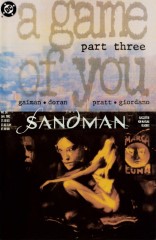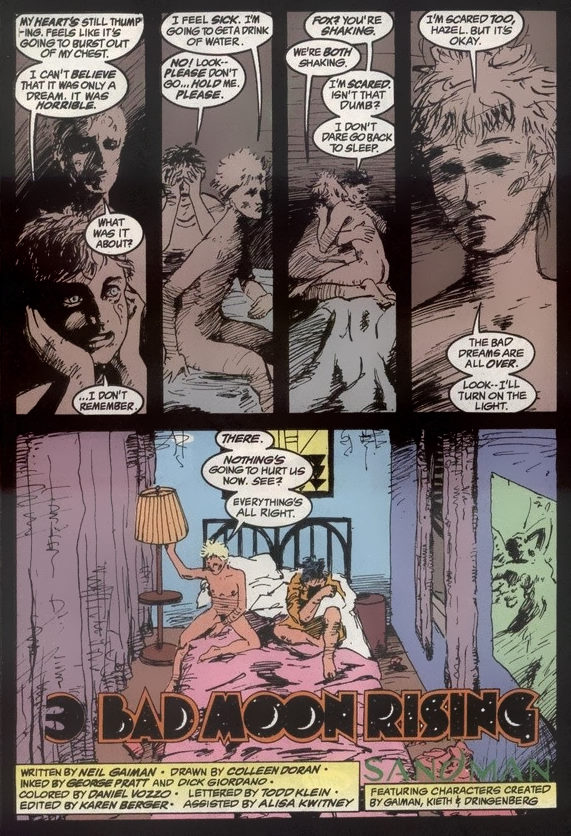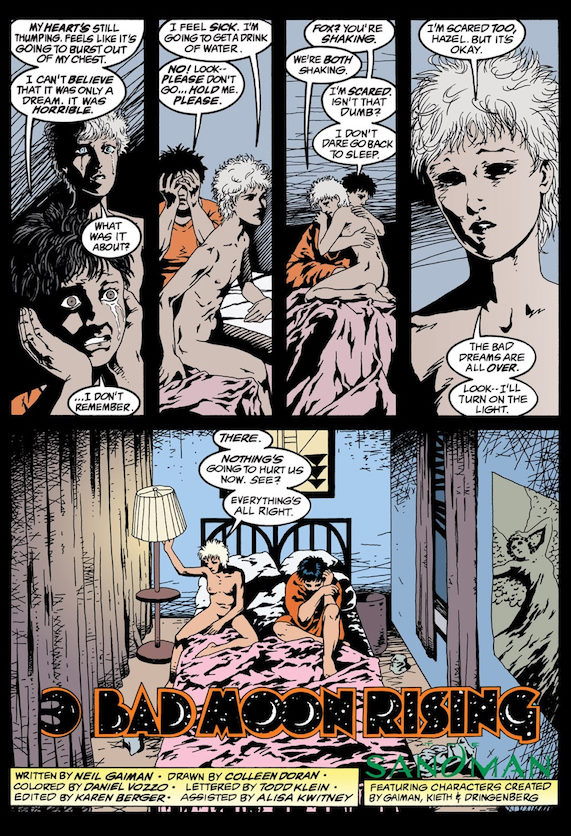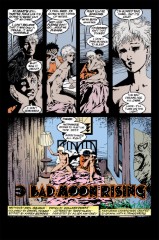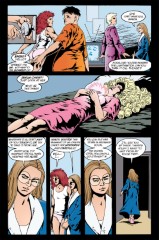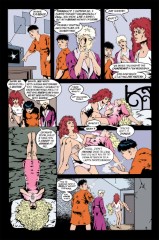Issue 34: "Bad Moon Rising"
Neil Gaiman, Colleen Doran, [George Pratt and Dick Giordano]
- Third part of storyline A Game of You
- Third story reprinted in trade paperback A Game of You
- Audible Act II Chapter 14
Title: A Game of You clearly refers to the question of identity. Who and what the characters in this story are is a question either to the readers or to the character him, her, or itself, and that is the most important theme the reader should keep in mind when reading this story.
"Bad Moon Rising" is a song by Credence Clearwater Revival; the relevant line in the song is "I see a bad moon rising". The stylized '3' in the title is the chapter number.
In the original edition, the inking was not up to quality. According to hearsay, George Pratt inked Doran's pencils in two days. According to Neil Gaiman, Pratt left for vacation leaving the last four pages undone. Dick Giordano inked those, deliberating using a style similar to Pratt's. Doran has threatened to "break Pratt's fingers" if he ever comes near her art again, and now has an "inker approval" clause in her contracts with DC.
For the Absolute edition, Colleen got to re-ink the artwork herself, and so the vastly improved version is used for all modern versions.
George Pratt's version on the left - Colleen Doran's re-inked version on the right.
Page 1#
Panel 2
The birds, which were causing or feeding off of the bad dreams of the house's occupants, disappear, quite probably at the exact same time that George was killed (last issue, last scene).
Page 2#
Panel 5
Note the poster of the angelic figure.
Page 4#
Panel 6
Thessaly has no sense of humor; this will be elaborated on later. Note that Wanda lives in apartment 2, which is probably a numerological reference to her dual nature (explained later).
Page 5#
Panel 5
This is one of the few places that Doran's style survived the inking; Wanda's hair in particular, as well as her stance, screams "Doran".
Note that Barbie lives in apartment 1; fitting, since she is the primary character and the center around whom this arc revolves.
Page 6#
Panel 2
The Porpentine has changed shape again.
Page 7#
Panel 6
Shortcomings: a pun.
Page 10#
Panel 4, 6-8
Another obviously Doran sequence. Keep in mind that Gaiman usually writes in full script; this is a good example of Gaiman's technical skill and flexibility, to write to a particular artist's style.
Page 11#
Panel 3
This is probably the same utility knife George used earlier.
Page 12-13#
Thessaly's flaying of George's face is taken directly from the practices of Greek witches, as reported by the third century AD Latin writer Apuleius, in "The Golden Ass". It is extremely significant that Mount Thessaly in Greece was a center of activity of these witches. The practice may have its roots in Sumeria and Babylonia, whose inhabitants wore the faces of their dead enemies, in accordance with the traditions of sympathetic magic.
In medieval times, demons were believed to flay their victims and wear their skins to fool mortals; in certain varieties of Satanism, the skin of a sacrificial victim is the gateway to Hell (which may be seen in certain issues of the comic book Grimjack). George's skin is not exactly the gateway to the Dreaming, but there is some parallelism there.
Page 14#
Panel 3
High Shore of the Silent River: No refs. In Greek mythology, the River Styx was one of the boundaries between the land of the living and the land of the dead. Other mythological rivers include Acheron, Cocytus, Phlegethon (the River of Fire) and Lethe (the River of Forgetfulness).
Page 15#
Panel 1
Gwas-y-gog: Welsh, meaning literally "Servant of the cuckoo"; it is also the name of a little brown bird, which may be the one known as "hedge-sparrow" in English.
Why Welsh? Probably because of the rich influence Welsh culture has had on English folktales, and probably because of the existence of that little brown bird, as a real-life antecedent.
Panel 2
George's statement here is unclear. The cuckoo sent him here, but came to him here and seduced him with promises. Is he a creature of the Dreaming, or a man taken over by the Cuckoo's will?
Panel 5
It is a cliche that you pinch yourself to shock yourself out of a dream.
Page 16#
Panel 9
Is Thessaly referring to Dream's ruby, or to another, similar, stone brought forth from dreams? Most likely the former.
Page 17#
Panel 6
Even assuming that all four women are capable of menstruation, and assuming that Hazel and Foxglove aren't in sync, it's only about 50% probable that any one of them would be menstruating at any given time (based on a period lasting five days in 30, which is a simplification). Given that Hazel and Fox are in sync, and Thessaly and Wanda are incapable, it's really only about a 1 in 6 chance that menstrual blood would be available. This is perhaps the first time that Gaiman has had a story point depend purely on chance, however elegantly it may have been foreshadowed. Thessaly, it is hinted, is very old. Since ovulation is a linchpin in the menstrual cycle, and since the supply of eggs in the human female is finite and in the hundreds or thousands, it is no surprise that Thessaly has stopped menstruating, even though she retains apparent youth. She's simply run out of eggs.
Panel 9
We have seen no other evidence that Dream bears some sort of prejudice against lesbians or witches. Dream generally spares little time for any mortals.
Page 18#
Panel 3
Thessaly, Hazel, and Foxglove together make up a maiden, mother, crone triune; this summons the power of the Triple Goddess.
Panel 4
Gorgo: the Greek root /gorgos/ means "grim, fierce, terrible". This may refer simply to the Gorgon Medusa, one of three horrifyingly grotesque daughters of the sea-god Phorkys in Greek myth, slain by Perseus; variant spellings occasionally left off the 'n'. Also, a common variant for Gorgas "sea-nymphs" is Gorgides, with an implied singular Gorgo.
Mormo: A Greek bogeyman/bugbear, used to frighten children. Lamachus (who?) had the Mormo on his helmet. She is definitely feminine, possibly akin to the Lamia.
Ereschigal: Ereshkigal, variously known as Allatu/Allatum ("Alatu" is Akkadian for "goddess"), or Gula (Sumerian for "Queen"), is a deity native to the Fertile Crescent, and therefore worshipped in some form by the Sumerians, Babylonians, Assyrians, Hittites, Hurians, and so on. She is generally spoken of as the chief Babylonian goddess of the underworld, sister of Ishtar/Inanna, and shares the throne of the underworld Irkalla with Nergal (familiar as a demon to readers of the comic book Hellblazer). Gorgo, if taken as "sea nymph", Mormo, and Ereshkigal form a Maiden- Mother-Crone triplet.
Note that Foxglove, Hazel, and Thessaly also form a Maiden-Mother-Crone triplet.
This chant is very similar to the one H.P. Lovecraft used in "Horror at Red Hook."
Page 19#
Panel 1
Note the three faces.
Page 21#
Panel 1
The bag lady says "Moon's gone weirdzo/Look at the son of a bitch." Weirdzo is a reference to the Bizarros, mentioned earlier.
Page 22#
Panel 4
Lunatic, meaning madman, originally arose from the belief that the full moon influenced madness. Its use here is overtly ironic.
Page 23#
Panel 1-3
The bag lady, possibly mad, recognizes what happened to the moon. Is it a consequence of her madness, or is it simply as she says in panel 3, that no one bothers to look at the sky any more?
Panel 6
Rabbit hole: a reference to Lewis Carroll's Alice's Adventures in Wonderland, where the heroine falls down a rabbit hole into a strange other world. Stephen King: An extremely popular American writer of horror stories.
Panel 7
Wanda is playing "the game of you".
Page 24#
Panel 2
Goody Two-Shoes: A cliche meaning a do-gooder; often used derisively. It arises from an anonymous allegory published in English in 1766 under the somewhat unwieldy title:
"The history of little Goody Two-Shoes:
Otherwise called, Mrs. Margery Two-Shoes.
With the means by which she acquired her learning and wisdom,
And in consequence thereof her estate;
Set forth at large for the benefit of those,
Who from a state of rags and care,
And having shoes but half a pair;
Their fortunes and their fame would fix,
And gallop in a coach and six."It is by reputation simplistic and moralistic; the heroine exemplifies the type of person her name came to represent. "Goody" itself is short for "Goodwife", and was used in a sense roughly equivalent to "Mrs." Margaret Hamilton: Played the Wicked Witch of the West in the movie version of The Wizard of Oz.
Panel 5-6
George should be enjoined from speaking except with Thessaly's permission; see page 16 panel 1. This is hand waved away in the next issue.
Credits
- Originally collated and edited by Greg Morrow.
- Jim W Lai jwtlai@jeeves.uwaterloo.ca pointed out the correlation between George's death and the disappearance of the birds; Thessaly's sense of humor and the significance of apartment numbers; mythical rivers; Dream's attitude toward mortals; Mormo's meaning; and the connection between the mad and the moon.
- Jim also passed along some GEnie discussion, including Laura Osgood's (L.OSGOOD) remarks about Thessalian witches.
- Lance Smith lsmith@cs.umn.edu speculated about the Welsh origins of George's name.
- Andrew Moran andrew@cs.chalmers.se passed along a note from Geraint Jones, a Welsh speaker, fully explaining George's name.
- Glenn Alan Carnagey Jr lf7z@midway.uchicago.edu referenced the flaying of faces, Gorgo, Mormo, and Ereshkigal. Glenn provided extraordinary detail on the cross-cultural correspondences of deities related to Ereshkigal, which I have unfortunately had to remove.
- Mike "Killans" Collins (mcollins@nyx.cs.du.edu) noted the previous establishment of Foxglove's menstruation.
- Tanaqui Weaver (tweaver@nyx.cs.du.edu) passed along a note from Neil Gaiman about the inking.
- Jerry Stratton (jerry@teetot.acusd.edu) quoted Manfred Lurker's Dictionary of Gods and Goddesses, Devils and Demons.
- William Sherman sherman@math.ucla.edu referenced Goody Two-Shoes.
- Ralf Hildebrandt added a note about the chant on p18
- Richard Munn updated the note about the "bad art", and added the note from the letters page that's listed below in the Appendix.
Appendix: From the #34 letters page
As for SANDMAN readers being more than passive scholars, I would like to mention here that someone a few letter columns ago caught a nuance that went completely over my head. "Death" is not called "Death" by her siblings for a very real reason, according to Neil.
This is a very good point - by what name do they call her?
Last modified by Richard Munn on 2023-08-21 - Fixed some formatting, and improved blockstyle plugin behaviour
[edit this page] [page history]
